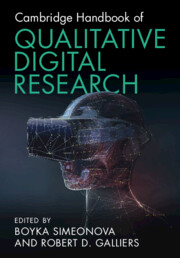Book contents
- Cambridge Handbook of Qualitative Digital Research
- Cambridge Handbook of Qualitative Digital Research
- Copyright page
- Contents
- Figures
- Tables
- Contributors
- Preface
- Part I Philosophical, Epistemological and Theoretical Considerations
- Part II Methodological Considerations
- Part III Illustrative Examples and Emergent Issues
- Chapter 13 Observing Artifacts
- Chapter 14 Algorithms as Co-Researchers
- Chapter 15 Sensemaking about HRV Data of High-Performing Individuals
- Chapter 16 The Rich Facets of Digital Trace Data
- Chapter 17 Balancing the Momentum of Datafication with Qualitative Researchers as Design Thinkers
- Chapter 18 What Data Sharing in Government Tells Us about the Digitalization of Government Services
- Index
- References
Chapter 13 - Observing Artifacts
How Drawing Distinctions Creates Agency and Identity
from Part III - Illustrative Examples and Emergent Issues
Published online by Cambridge University Press: 08 June 2023
- Cambridge Handbook of Qualitative Digital Research
- Cambridge Handbook of Qualitative Digital Research
- Copyright page
- Contents
- Figures
- Tables
- Contributors
- Preface
- Part I Philosophical, Epistemological and Theoretical Considerations
- Part II Methodological Considerations
- Part III Illustrative Examples and Emergent Issues
- Chapter 13 Observing Artifacts
- Chapter 14 Algorithms as Co-Researchers
- Chapter 15 Sensemaking about HRV Data of High-Performing Individuals
- Chapter 16 The Rich Facets of Digital Trace Data
- Chapter 17 Balancing the Momentum of Datafication with Qualitative Researchers as Design Thinkers
- Chapter 18 What Data Sharing in Government Tells Us about the Digitalization of Government Services
- Index
- References
Summary
Today’s information technology is becoming ever-more complex, distributed and pervasive. Therefore, problematizing what we observe as Information Systems (IS) researchers is becoming ever-more difficult. This chapter offers a new perspective for qualitative empirical research in the IS field. It looks at how we can possibly study dynamically changing, evolving, spatially and temporally distributed phenomena that evade our accustomed concepts and assumptions about the locus of agency. Or asked differently: How can we formally approach phenomena evading our concept of ‘identity’?
Using the mathematical-logical framework of the Laws-of-Form, formulated in 1969 by George Spencer-Brown, the chapter introduces the notion of distinction to capture the manifestation of concepts. It provides a short overview and illustrates how it can be used on sample concepts drawn from IS sociomateriality research.
The chapter advances qualitative methodology by suggesting a formal notation to communication analysis that is reflective of technologies’ complex nature. Applying the framework not only alters the epistemological boundaries for how to experience and study the ‘digital’, but also helps to build a bridge between deep technological insights, our immediate, unbiased and mundane experience of technologies, and how we speak about them.
Keywords
- Type
- Chapter
- Information
- Cambridge Handbook of Qualitative Digital Research , pp. 193 - 210Publisher: Cambridge University PressPrint publication year: 2023



